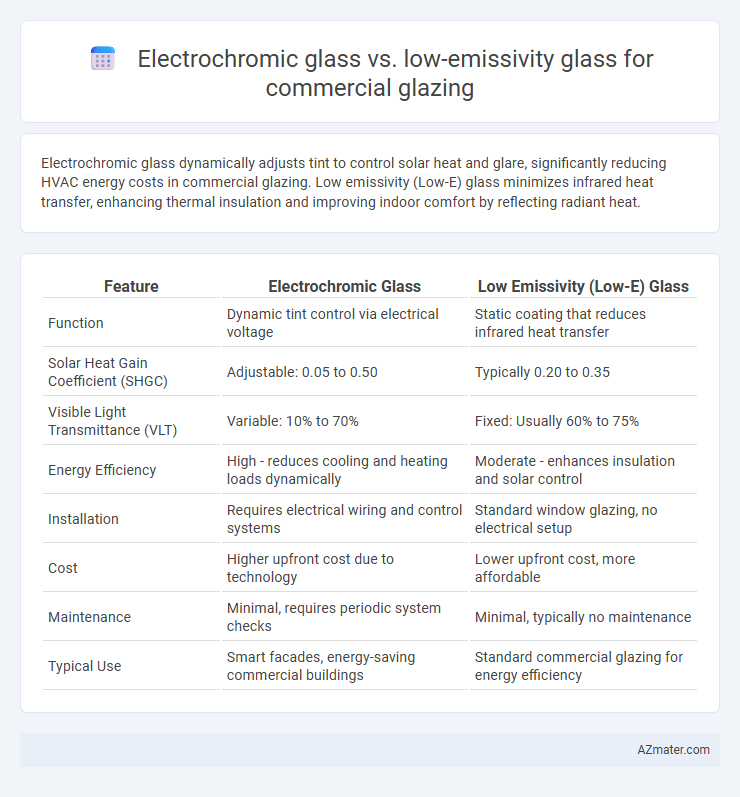Electrochromic glass dynamically adjusts tint to control solar heat and glare, significantly reducing HVAC energy costs in commercial glazing. Low emissivity (Low-E) glass minimizes infrared heat transfer, enhancing thermal insulation and improving indoor comfort by reflecting radiant heat.
Table of Comparison
| Feature | Electrochromic Glass | Low Emissivity (Low-E) Glass |
|---|---|---|
| Function | Dynamic tint control via electrical voltage | Static coating that reduces infrared heat transfer |
| Solar Heat Gain Coefficient (SHGC) | Adjustable: 0.05 to 0.50 | Typically 0.20 to 0.35 |
| Visible Light Transmittance (VLT) | Variable: 10% to 70% | Fixed: Usually 60% to 75% |
| Energy Efficiency | High - reduces cooling and heating loads dynamically | Moderate - enhances insulation and solar control |
| Installation | Requires electrical wiring and control systems | Standard window glazing, no electrical setup |
| Cost | Higher upfront cost due to technology | Lower upfront cost, more affordable |
| Maintenance | Minimal, requires periodic system checks | Minimal, typically no maintenance |
| Typical Use | Smart facades, energy-saving commercial buildings | Standard commercial glazing for energy efficiency |
Introduction to Commercial Glazing Technologies
Electrochromic glass offers dynamic tinting capabilities that enhance energy efficiency and occupant comfort by controlling solar heat gain and glare in commercial buildings. Low emissivity (Low-E) glass features a microscopically thin coating that reflects infrared energy, reducing heat transfer and improving thermal insulation without altering visible light transmission. Both technologies are integral to modern commercial glazing, optimizing building performance by balancing daylighting, energy savings, and thermal comfort.
What is Electrochromic Glass?
Electrochromic glass is a dynamic glazing technology that changes its tint in response to an electric voltage, allowing precise control over solar heat gain and natural light transmission in commercial buildings. Unlike low emissivity (Low-E) glass, which passively reduces heat transfer by reflecting infrared radiation, electrochromic glass actively adjusts opacity to optimize energy efficiency and occupant comfort. This smart glass reduces glare, lowers cooling costs, and enhances building sustainability by adapting to changing external conditions throughout the day.
Understanding Low Emissivity (Low-E) Glass
Low Emissivity (Low-E) glass features a microscopically thin, transparent coating that reduces infrared and ultraviolet light while allowing visible light to pass through, enhancing energy efficiency in commercial glazing. It minimizes heat transfer by reflecting interior temperatures back inside during winter and blocking external heat in summer, thereby reducing HVAC costs. Compared to electrochromic glass, Low-E glass offers passive solar control without the need for electrical input, making it a durable and cost-effective solution for building envelopes.
Energy Efficiency Comparison
Electrochromic glass offers dynamic solar control by adjusting tint levels, significantly reducing cooling loads and enhancing energy savings in commercial buildings. Low emissivity (Low-E) glass minimizes heat transfer by reflecting infrared radiation, improving insulation and reducing heating costs during colder months. Both technologies contribute to energy efficiency, but electrochromic glass provides adaptive control that optimizes daylight and thermal performance throughout the day.
Light and Solar Control Capabilities
Electrochromic glass offers dynamic light and solar control by adjusting tint levels in response to sunlight, reducing glare and heat gain while optimizing natural daylight. Low emissivity (Low-E) glass features a microscopically thin coating that reflects infrared radiation, minimizing heat transfer and improving thermal insulation without altering visible light transmission. For commercial glazing, electrochromic glass provides adaptive solar control suited for variable conditions, whereas Low-E glass delivers consistent energy efficiency by blocking solar heat while maintaining clear daylight.
Durability and Maintenance Requirements
Electrochromic glass features a durable multilayer coating that allows dynamic tint adjustment while requiring minimal maintenance, as it resists fading and scratching under typical commercial conditions. Low emissivity (Low-E) glass incorporates nanoscale metallic coatings designed to reduce infrared and ultraviolet light transmission, enhancing thermal performance with a long lifespan but may require more frequent inspections to ensure coating integrity. Both types offer robust durability for commercial glazing, though electrochromic glass demands less upkeep due to its self-regulating tint properties.
Installation Considerations and Costs
Electrochromic glass installation requires integrating electrical wiring and control systems, typically increasing upfront costs compared to low emissivity (Low-E) glass, which installs similarly to traditional glazing without added electronic components. Low-E glass offers straightforward installation with minimal modifications to standard framing systems, making it a cost-effective choice for large-scale commercial projects seeking passive solar control. Maintenance and operational expenses for electrochromic glass can be higher due to electronic components, while Low-E glass provides long-term savings through enhanced thermal insulation without additional energy input.
Smart Building Integration
Electrochromic glass offers dynamic solar control by adjusting tint levels in real-time, significantly reducing cooling loads and enhancing occupant comfort in smart commercial buildings. Low emissivity (Low-E) glass provides superior thermal insulation by minimizing infrared and ultraviolet light transfer, improving energy efficiency but lacks adaptive control features. Integrating electrochromic glass with smart building systems enables automated daylight management and energy optimization, whereas Low-E glass primarily supports baseline thermal performance without active responsiveness.
Environmental Impact and Sustainability
Electrochromic glass dynamically controls solar heat and glare by adjusting tint, significantly reducing energy consumption for lighting and HVAC in commercial buildings. Low emissivity (Low-E) glass minimizes heat transfer through its microscopically thin metal oxide coating, improving insulation and reducing heating and cooling demands. Both technologies enhance sustainability by lowering greenhouse gas emissions, but electrochromic glass offers greater energy savings through adaptive light modulation, promoting higher environmental efficiency.
Choosing the Right Glass for Your Commercial Project
Electrochromic glass offers dynamic tinting capabilities that adjust to sunlight intensity, reducing glare and solar heat gain while enhancing occupant comfort in commercial buildings. Low emissivity (Low-E) glass optimizes energy efficiency by minimizing infrared and ultraviolet light transfer without compromising natural daylight. Selecting between electrochromic and Low-E glass depends on project goals such as energy savings, occupant comfort, and facade aesthetics, with electrochromic favored for adaptive control and Low-E for consistent thermal performance.

Infographic: Electrochromic glass vs Low emissivity glass for Commercial glazing
 azmater.com
azmater.com